Business Visualizations
The Biggest Fortune 500 Company in Every State
Every year, Fortune magazine publishes its much-anticipated Fortune 500 list. This list is meticulously analyzed by company owners, investors, and influential figures in the business world. So, what makes the Fortune 500 so significant? In this article, our team at The Chartistry provides an in-depth examination of the list, exploring why it attracts so much attention and what it takes for a company to be included.
Click below to zoom
What is the Fortune 500?
The Fortune 500 is the finance magazine’s list of the 500 most profitable companies in the United States. The company ranked at the top of the list brings in the most revenue based on its financial documents from the most recent fiscal year. The Fortune 500 list for 2024 has Walmart ranked in the top spot with revenue of $648.125B. In fact, this giant retail store has been ranked number one for the last eleven years.
What Does It Take to Make It Onto the Fortune 500?
To become a Fortune 500 company, a business must be incorporated and conduct operations in the U.S. In addition, the company’s financial documents must be public for it to be considered by Fortune.
Why Do Companies Want to Be on This List?
Fortune magazine published its first list of the top 500 U.S. companies in 1955. Since then, the presence of reputable companies such as Exxon Mobil, Goldman Sachs Group, and General Mills has given the list an air of prestige. Plus, these 500 businesses bring in incredible amounts of revenue and contribute to the strength of our economy. Wouldn’t you want your company to appear on a list alongside Walmart, Amazon, and Berkshire Hathaway?
Have Any Companies Appeared on the Fortune 500 for Decades?
Yes, some companies have made repeated appearances. Some famous names have been on the list every year since 1955, including Kellogg, Chevron, and Exxon Mobil, to name a few.
Fortune 500 Companies by State
Walmart, the number one ranked company on the Fortune 500, is located in Arkansas, with its headquarters in Bentonville. Fortune’s number two company, Amazon, is the biggest in Washington, with its headquarters in Seattle. Exxon Mobil is the biggest Fortune 500 company in Texas, and it does business out of Houston.
An interesting thing to note about this list is that not all 50 states are home to a Fortune 500 company. The states without one include:
- Alaska
- Hawaii
- Maine
- Mississippi
- Montana
- New Hampshire
- New Mexico
- North Dakota
- South Dakota
- Utah
- Vermont
- West Virginia
- Wyoming
The Largest Fortune 500 Company Headquartered in Each State
| State | Biggest Fortune 500 Company |
Location of Headquarters |
Fortune 500 Rank (2023) |
2023 Revenue (in millions) |
Percent Change in Revenue From 2022 |
| Alabama | Regions Financial | Birmingham, AL |
483 |
$7,531 |
14% |
| Alaska | N/A | N/A | N/A | N/A | N/A |
| Arizona | Avnet | Phoenix, AZ |
163 |
$24,311 |
24.4% |
| Arkansas | Walmart | Bentonville, AR |
1 |
$611,289 |
6.7% |
| California | Apple | Cupertino, CA |
4 |
$394,328 |
7.8% |
| Colorado | Arrow Electronics | Centennial, CO |
109 |
$37,124 |
7.7% |
| Connecticut | Cigna Group | Bloomfield, CT |
15 |
$180,516 |
3.7% |
| Delaware | DuPont | Wilmington, DE |
250 |
$16,549 |
-3.6% |
| District of Columbia | Fannie Mae | Washington, D.C. |
28 |
$121,596 |
19.7% |
| Florida | World Kinect | Miami, FL |
70 |
$59,043 |
88.4% |
| Georgia | Home Depot | Atlanta, GA |
20 |
$157,403 |
4.1% |
| Hawaii | N/A | N/A | N/A | N/A | N/A |
| Idaho | Albertsons | Boise, ID |
53 |
$71,887 |
3.2% |
| Illinois | Walgreens Boots Alliance | Deerfield, IL |
27 |
$132,703 |
-10.7% |
| Indiana | Elevance Health | Indianapolis, IN |
22 |
$156,595 |
13% |
| Iowa | Principal Financial | Des Moines, IA |
236 |
$17,492 |
22.6% |
| Kansas | Seaboard | Merriam, KS |
364 |
$11,243 |
21.8% |
| Kentucky | Humana | Louisville, KY |
42 |
$92,870 |
11.8% |
| Louisiana | Lumen Technologies | Monroe, LA |
237 |
$17,478 |
-11.2% |
| Maine | N/A | N/A | N/A | N/A | N/A |
| Maryland | Lockheed Martin | Bethesda, MD |
60 |
$65,984 |
-1.6% |
| Massachusetts | General Electric | Boston, MA |
52 |
$76,555 |
3.2% |
| Michigan | Ford Motor | Dearborn, MI |
19 |
$158,057 |
15.9% |
| Minnesota | UnitedHealth Group | Minnetonka, MN |
5 |
$324,162 |
12.7% |
| Mississippi | N/A | N/A | N/A | N/A | N/A |
| Missouri | Centene | St. Louis, MO |
25 |
$144,547 |
14.7% |
| Montana | N/A | N/A | N/A | N/A | N/A |
| Nebraska | Berkshire Hathaway | Omaha, NE |
7 |
$302,089 |
9.4% |
| Nevada | MGM Resorts International | Las Vegas, NV |
315 |
$13,128 |
35.6% |
| New Hampshire | N/A | N/A | N/A | N/A | N/A |
| New Jersey | Johnson & Johnson | New Brunswick, NJ |
40 |
$94,943 |
1.2% |
| New Mexico | N/A | N/A | N/A | N/A | N/A |
| New York | JPMorgan Chase | New York, NY |
23 |
$154,792 |
21.7% |
| North Carolina | Bank of America | Charlotte, NC |
32 |
$115,053 |
22.6% |
| North Dakota | N/A | N/A | N/A | N/A | N/A |
| Ohio | Cardinal Health | Dublin, OH |
14 |
$181,364 |
11.6% |
| Oklahoma | Oneok | Tulsa, OK |
173 |
$22,387 |
35.3% |
| Oregon | Nike | Beaverton, OR |
93 |
$46,710 |
4.9% |
| Pennsylvania | Cencora | Conshohocken, PA |
11 |
$238,587 |
11.5% |
| Rhode Island | CVS Health | Woonsocket, RI |
6 |
$322,467 |
10.4% |
| South Carolina | Sonoco Products | Hartsville, SC |
498 |
$7,251 |
29.7% |
| South Dakota | N/A | N/A | N/A | N/A | N/A |
| Tennessee | FedEx | Memphis, TN |
41 |
$93,512 |
11.4% |
| Texas | Exxon Mobil | Houston, TX |
3 |
$413,680 |
44.8% |
| Utah | N/A | N/A | N/A | N/A | N/A |
| Vermont | N/A | N/A | N/A | N/A | N/A |
| Virginia | Freddie Mac | McLean, VA |
45 |
$86,717 |
31.6% |
| Washington | Amazon | Seattle, WA |
2 |
$513,983 |
9.4% |
| West Virginia | N/A | N/A | N/A | N/A | N/A |
| Wisconsin | Northwestern Mutual | Milwaukee, WI |
111 |
$36,921 |
0.5% |
| Wyoming | N/A | N/A | N/A | N/A | N/A |
Do Some States Have More Than One Fortune 500 Company?
Yes, several states have multiple companies on the list. Texas leads with 55 companies on the Fortune 500, followed by California with 52 and New York with 50. These states all boast a large population and bustling metropolitan areas.
Do Some States Have Just One Fortune 500 Company?
Yes, some states on the list are home to just one. These states include Delaware, Kansas, Kentucky, and South Carolina. In terms of total population, each of these states ranks in the lower half on the list of 50. Delaware has the lowest population, with 1,044,320 people in 2024.
Are Some Cities Home to More Than One Fortune 500 Company?
Absolutely! In fact, some cities serve as the home base for multiple Fortune 500 companies. Some notable examples include:
Chicago
Illinois has 33 Fortune 500 companies, including Walgreens, McDonald’s, and United Airlines, among others. Dozens of these companies are headquartered in the Chicago area.
Houston
Of the 55 Fortune 500 companies in Texas, Houston is home to 21. Exxon Mobil, Sysco, and Hewlett Packard Enterprise (HPE) are just a few of the impressive companies in the collection.
Atlanta
According to our chart, the biggest Fortune 500 company in Georgia is Home Depot, ranked at number 20. But Home Depot is not alone. There are 18 Fortune 500 companies in Atlanta, including Aflac, Delta Air Lines Inc., The Coca-Cola Company, UPS, and others.
Make sure to explore our other lists and visuals, which provide insight into the world of big business. One list ranks companies by employee profits (which happens to be one of our original visualizations), while another categorizes the most profitable companies by industry. It’s no surprise that many Fortune 500 companies frequently appear on various lists throughout the year, highlighting their achievements.
The Number of Fortune 500 Companies in Each State
| State | State Abbreviation | Number of Fortune 500 Companies in Each State |
| Texas | TX |
55 |
| California | CA |
52 |
| New York | NY |
50 |
| Illinois | IL |
33 |
| Ohio | OH |
24 |
| Virginia | VA |
24 |
| Florida | FL |
23 |
| Pennsylvania | PA |
23 |
| Georgia | GA |
19 |
| Michigan | MI |
18 |
| Massachusetts | MA |
17 |
| Minnesota | MN |
15 |
| Connecticut | CT |
14 |
| New Jersey | NJ |
14 |
| North Carolina | NC |
13 |
| Washington | WA |
12 |
| Arizona | AZ |
10 |
| Colorado | CO |
10 |
| Tennessee | TN |
10 |
| Missouri | MO |
8 |
| Wisconsin | WI |
8 |
| Indiana | IN |
7 |
| Oklahoma | OK |
6 |
| Arkansas | AR |
4 |
| Nebraska | NE |
4 |
| Rhode Island | RI |
4 |
| Idaho | ID |
3 |
| Maryland | MD |
3 |
| Alabama | AL |
2 |
| District of Columbia | DC |
2 |
| Iowa | IA |
2 |
| Louisiana | LA |
2 |
| Nevada | NV |
2 |
| Oregon | OR |
2 |
| Delaware | DE |
1 |
| Kansas | KS |
1 |
| Kentucky | KY |
1 |
| South Carolina | SC |
1 |
| Alaska | AK |
0 |
| Hawaii | HI |
0 |
| Maine | ME |
0 |
| Mississippi | MS |
0 |
| Montana | MT |
0 |
| New Hampshire | NH |
0 |
| New Mexico | NM |
0 |
| North Dakota | ND |
0 |
| South Dakota | SD |
0 |
| Utah | UT |
0 |
| Vermont | VT |
0 |
| West Virginia | WV |
0 |
| Wyoming | WY |
0 |
Source:
Business Visualizations
Ranking States by Workplace Cleanliness
The team at Stratus Building Solutions reveals which states have the cleanest and dirtiest workplaces in a new study. Cleanliness is often an overlooked but powerful influence on workers’ health, happiness, and productivity. People who work in an office spend many hours there and have a right to a clean, safe space to work, whether that’s at their desk, in the breakroom, or in the bathroom. The team’s study reveals that cleanliness depends on more than company policy and culture. It’s impacted by resources and state laws. While some states mandate rules that boost workers’ health and safety, other locations lack such protections and put workers at risk.
Click below to zoom.
The team created a scoring system based on some key criteria. First was the number of OSHA violations. OSHA is the Occupational Safety and Health Administration, which sets federal workplace safety standards, including sanitation standards. A state with a high number of OSHA sanitation violations is a clear sign of dirty workplaces. These violations could include unclean restrooms, inadequate waste disposal, or the presence of mold and bacteria. The team also examined the number of janitors per capita, population density, air pollution, and sick leave laws in each state.
The team found that these states were the cleanest with the highest scores:
- Nebraska
- Colorado
- North Dakota
- South Dakota
- Washington
- Missouri
- Montana
- Idaho
- Michigan
- New Mexico
The top scorers had low rates of OSHA violations, clean air, and high janitor-to-population ratios. State laws mandating sick leave also play a major role, as workers are more likely to stay home rather than bring germs to work.
These were the states that struggled the most with these standards:
- Tennessee
- North Carolina
- Mississippi
- Virginia
- Connecticut
- Oregon
- Nevada
- Rhode Island
- Alabama
- New Jersey
- Pennsylvania
Many of these states are on the dirty end of the spectrum, lacking paid sick leave. Tennessee, Mississippi, and North Carolina do not have laws on paid sick leave, which, when combined with the absence of handwashing stations and disinfecting services, makes the workplace a petri dish for germs. We also see heavily populated states like New York and New Jersey on the low end of the spectrum because more people means a greater challenge to clean up waste and keep germs at bay. High populations also mean bigger cities and more air pollution. We do see, however, that lower population density doesn’t necessarily mean cleaner workplaces, as Vermont was near the bottom of the list and has a small population.
Clean workplaces are healthy workplaces. Dust, germs, and air pollution lead to gastrointestinal and respiratory problems among workers. Simple precautions like regularly disinfecting surfaces, installing handwashing stations, and removing dust can boost the cleanliness of the office and the health of workers. Healthy workers mean better productivity and greater safety for all. Not only will a clean space improve worker experience, but OSHA violations can be very costly. The team’s study provides fascinating insights into what affects workplace cleanliness.
Business Visualizations
New Study Examines Language Used to Let Employees Go
Letting an employee go is an unpleasant experience for everyone involved, but language has the power to guide the emotions surrounding an interaction. While the right words won’t erase the bad side of being let go, they can help the employee in question understand why the situation is happening and make them feel seen and heard. Preply leaned into the language aspects in these situations with a study examining the most common phrases and words used when letting an employee go and how employers and employees felt about the situation.
Click below to zoom.
Overall, the team found that these were the most common phrases used:
- Letting you go
- Effective immediately
- Terminating your employment
- This isn’t working out
- No longer require services
- Parting ways
- Ending your employment
- No longer needed
- Relieved of duties
- Ending our working relationship
Managers and employees seem to agree that lack of empathy and responsibility were the most common complaints about the process. One in six managers say they regret the words they chose when firing someone, and 92% feel they need more training on how to handle such situations. Employees wanted their managers to focus on clarity, compassion, empathy, and honesty when firing an employee.
The team studied changes that both managers and employees would like to see in the firing process.
These are the six things employees want to see improved:
- Better explanation
- Better empathy
- Taking responsibility rather than avoiding blame
- Face-to-face conversation rather than electronic
- Fewer team members involved in the firing
- Don’t compare fellow employees
Here’s how that compares to changes managers would like to make to the process:
- Better explanation
- Better empathy
- Face-to-face conversation rather than electronic
- Don’t compare fellow employees
- Taking responsibility rather than avoiding blame
- Fewer team members involved in firing
These are similar answers, but we can see that the two groups ranked their importance differently. Overall, 92% of Americans think managers could benefit from some language training when it comes to firing someone. Empathy and honesty were high on the list of employee wishes, indicating that understanding can help give them closure on the job, and empathy softens the blow. Not many managers would prefer a face-to-face meeting. Only 1 in 6 prefer this to virtual meetings, which seem to be the most common option.
Only 55% of managers have received training on how to fire someone, and with many of them regretting their language choices, it seems that many managers would benefit from some education in business language and communication. Notice that many of the top phrases are more professional ways to say “fired,” like “letting you go,” “terminating,” and “no longer require.”
When managing a team, empathy and clear language are crucial. These skills can help managers excel at many tasks beyond having to let an employee go. But when a situation like firing someone is emotionally charged, the language used becomes more important than ever. Hopefully, the team’s study can help managers reflect on how they go about the process.
Business Visualizations
Study Examines the Ways Americans Resign from Jobs
Over 1,000 Americans responded to a survey from the Preply team that studied how Americans communicate when they quit their jobs. In 2025, over 3 million Americans quit their jobs, clearly indicating resigning is a common occurrence. But this study reveals that people have different approaches to quitting, as well as some commonalities. The team’s analysis encompasses the methods used to resign as well as the tone, language, and feelings surrounding the resignation.
Click below to zoom.
Most Americans reported a verbal resignation. 76% of the survey responders used this direct and personal approach to quit their jobs, while only 9% gave a handwritten notice of resignation. That’s surprisingly fewer than the number who “ghosted” their employer at 19%. Around 10% of workers quit via text, leading to 43% reporting that their resignation only lasted a few minutes. Quitting can be awkward and uncomfortable, so it makes sense that people want to get the conversation over with. Those who quit in letter or text said they sent “just a few words.”
The next aspect the team considered was the tone and language used in the resignation. Naturally, many employees would want to avoid burning bridges when they quit. 91% of employees said they avoided using negative or critical language when resigning. 64% said they were conscious of using a polite tone, and 27% went as far as using apologetic tones and words. 60% of employees had to suppress their negative emotions and refrained from stating the critical reasons that led to their resignation.
There were some differences among ages and genders as well. Gen Z was the most restrained when resigning, with 61% stating that they held back emotions during the process. Boomers and Gen X were similar at 59% and 58% respectively. Millennials held back the least at 57%. As for gender, 63% of women said they suppressed their emotions and 53% of men reported the same. The team found that when employers offered exit interviews, 40% of workers felt more comfortable expressing their honest experiences at the company, which is important for companies that take worker experience and company culture seriously.
Most people said they avoided language, but here’s the specific breakdown of the tones they used when they quit:
- Polite – 64%
- Neutral – 54%
- Apologetic – 27%
- Angry – 12%
- Passive-aggressive – 12%
- Sarcastic – 6%
While people may hold back their negative feelings when resigning, that doesn’t mean these employees are above cutthroat tactics. One in eight people said they chose to resign at a time when they knew it would cause the most disruption and harm at work. Gen Z was the most likely to do this, and men were more likely than women. One in ten left negative or scathing reviews of their former company on sites like Glassdoor. Healthcare workers were the most likely to do this. These reviews often included negative words like “disorganized”, “stressful”, and “frustrating.” These written reviews often express things employers weren’t comfortable saying in person.
The trends and findings in this study provide a well-rounded look at a common experience, revealing surprising similarities among people in very different situations.
-
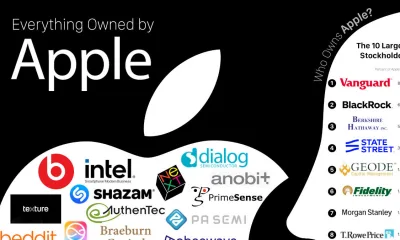
 Business Visualizations1 year ago
Business Visualizations1 year agoEverything Owned by Apple
-
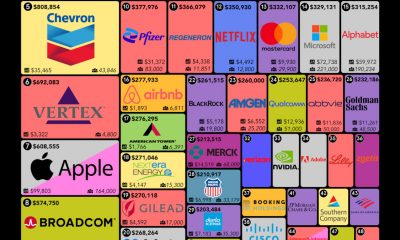
 Business Visualizations1 year ago
Business Visualizations1 year agoAmerica’s Most Valuable Companies Ranked by Profit per Employee
-
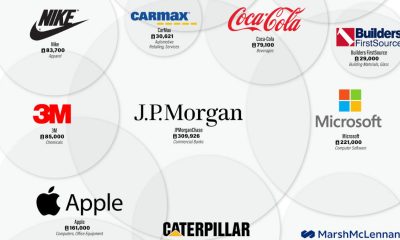
 Business Visualizations7 months ago
Business Visualizations7 months agoThe Biggest Employers by Industry
-

 Maps2 years ago
Maps2 years agoPenis Lengths Around the World
-
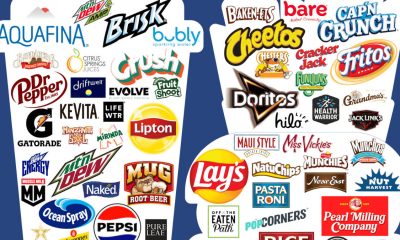
 Business Visualizations2 years ago
Business Visualizations2 years agoAll The Brands Owned By PepsiCo
-
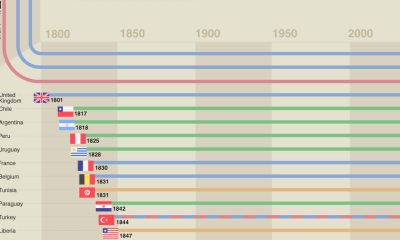
 Timelines2 years ago
Timelines2 years agoA History of the Oldest Flags in the World
-

 Business Visualizations2 years ago
Business Visualizations2 years agoNew Animated Map Shows Airbnb’s Fully Booked Cities Along the 2024 Eclipse Path of Totality
-

 Business Visualizations2 years ago
Business Visualizations2 years agoEverything the Luxury Giant LVMH Owns in One Chart
















